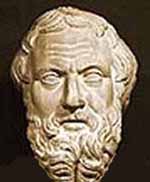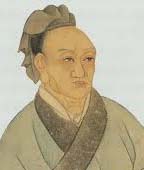Presenting History
NarrativeOK, you have it, and you got it honestly, and are ready to bring it before others. How to structure the presentation? Almost any reality worth bothering with is more complex than a single paragraph can contain, and more diverse than a single story will present. What then?
Herodotus, it is said, recited his History to audiences in Athens. Such a presentation is necessarily linear: the voice can say only one thing at a time. The basic way of presenting history is still by a single consecutive narrative, or exposition. Needless to say, no single narration can do justice to, or can even mention, all that one might know about the past. The basic fact about a narrative is that it selects some facts from all the known facts, presumably in the service of some tendency observed in the facts, and that it arrives somewhere, presumably the denouement to which the facts point, or the conclusion which the tendency suggests. A personal diary, or an individual speech, is radically linear in that as a literary form (or accumulation) it has its own internally defined point of ending. The linear narrative, which Thucydides went on to master, gains point and impact precisely by leaving out a lot of other stuff and cleaving, despite any digressions along the way, to its story line. Narratives thus have endings.
But history as such does not have an ending; it keeps happening, and it happens along many simultaneous tracks. This is the problem of narrative history.
One solution to the inadequacy of a linear narrative to convey a multilinear fact was found by Szma Tan around the year 0139. He had indeed (1) his primary narrative (the doings of the emperors, one after the other), a sequence of 12 chapters in all. Very good; we have now reached the level of Suetonius and his Twelve Caesars (c100). But Szma Tan kept on going. In parallel to this, not worked into the narrative as asides but set forth separately in different parts of the book, he also had (2) chronological tables, organizing data very simply against time, and stripped of narrative for easier perception; (3) treatises on important subjects like ritual and music and the calendar, which lent themselves to static if complex description; (4) accounts of the states which had preceded the founding of the Empire in which Szma Tan himself lived; and (5) sixty - count 'em, sixty - accounts of individuals, or groups of individuals (cruel officials, diviners, merchants) or even foreign peoples. Each of the chapters of the total Shr Ji (there were originally 120, later expanded to 130 by Tan's son Szma Chyen) has its own descriptive or narrative logic, with its own sometimes arresting anecdotal details. Each is independent of the others, and in effect is meant to be read in parallel with the others. None of the narratively organized sections interferes with, or is distracted by, any of the others (though there are some key cross-references). All the voices sound, but separately. Only after finishing the whole work can the reader claim to have - not a narrative experience, to be sure, but a cumulative exposure to the situation: in this case, a whole society described in its contemporay complexity, and from the beginning of time to the present.
Most histories lie somewhere between the two. All we can dare to recommend is that the linear form (probably most people's choice) be at least challenged in the writer's mind by the richness available only, or most conveniently, through the multilinear model.
No method of presentation is perfect, and all sincerely meant and competently executed solutions have their value. Whether those solutions have enduring value is something that the community of readers of history will eventually decide. It may be observed meanwhile that new efforts to some extent presume the continued existence of older ones. They exploit the advantage that some things have been competently treated elsewhere, and build on that situation. This efficiency is to be applauded. The work of history, at any one point, is not embodied in any one book, but in the joint output of the historical enterprise. B repairs the gaps in A, leaving A still standard for what it did well. E extends the insights of C and D. H brings together the findings of F and G in a revealing way. Each is a part of the success of the others, and a corrective for the limitations of the others.
Describing society is probably too much to expect of any single work. That task is more nearly within the reach of a corpus of works (or a composite work like the Shr Ji, which aspires to corpus status under the rubric of a single title). No author could have produced the corpus, which is why there is a conscious collective effort. No reader can afford to buy the corpus, hence the existence of readership mechanisms called libraries. The nearest thing to success in the doing and telling of history may thus be institutional in nature.
Hug a librarian.
7 Nov 2000 / Contact The Project / Exit to Outline Index Page

